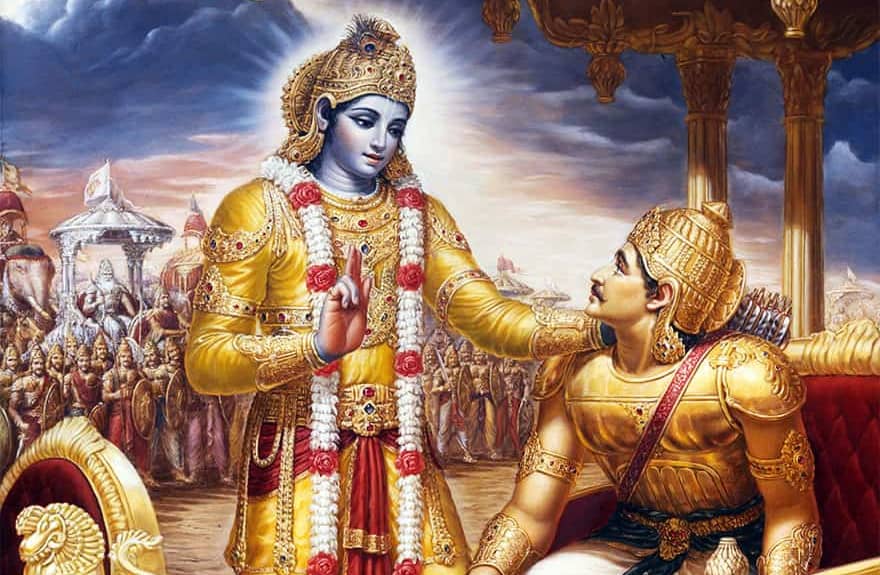18 styles of yoga according to Bhagavad Gita
Yoga is an ancient invention that is still celebrated today. Yoga is a set of specific exercises that comprise poses combined with breathing techniques, a mediation that directly benefits us mentally, physically, and emotionally. Involving yoga in our daily lifestyle relaxes us benefiting us with a better and brighter mood.
The ancient scripture of Hindus – Srimad Bhagavad Gita is a treasure for ‘yoga’ lovers. It is a holy book that speaks about the detached way of life through its 700 ‘shlokas’ divided into 18 chapters where 3 chapters have a great explanation of different types of yoga. The 18 Styles of yoga according to Bhagavad Gita are listed:
1 . Visada yoga
The style of yoga that is also known as the Yoga of the Dejection of the Spirit as it is a spiritual rule set and takes us from the very level in which we find ourselves detaching us from the chaos of this world. When Arjuna was confused about his duties and suffering from depression, Krishna approached him to try this method when his frustration was sky-scraping. That’s why this style of yoga is called Detection of the Spirit.
2. Sankhya yoga
Sankhya is a style of yoga, which means “empirical” or “number.” It is all about the process where implicit becomes explicit and where there exists neither production nor destruction. Philosophers and highly intellectual people prefer to practice this yoga.
3 . Karma yoga
Lord Krishna passed his knowledge to Arjuna and told him,” Karma yoga is the Greatest yoga anyone can practice”. It is a path of action and talks about our absolute duty. Karma yoga is all about being active and working for the betterment of ourselves and others.
4. Jnana yoga
It is the path of knowledge that discusses the characterized knowledge related to birth and activities of a supreme being. Lord Krishna says that there is nothing in this world more than knowledge.
5. Karma Vairagya Yoga
It is a spiritual practice of action performed for the benefit of others. Karma vairagya yoga (karma- sannyasa) is also called the path of renunciation of actions. This yoga explains about actions and inactions and working for Supreme.
6. Abhyasa yoga
It is the next style of yoga mention in Bhagavad Gita , which implies to self realization and self-control. It is practiced by great sages to receive discipline and achieve a tranquil state of mind. This style of yoga develops inner power and strengthen the mind, body and soul.
7. Paramahamsa Vijnana yoga
The nature of Krishna consciousness is fully described in this style of yoga here.
Paramahamsa Vijnana yoga describes the process of achieving supreme in the path of wisdom.
8. Aksara-Parabrahman yoga
It is the path of Imperishable Brahman. This style of yoga describes the nature of materialistic activities, living entities teaching how to remain connected to Supreme power and getting empowered with the practice of yoga.
9. Raja-Vidya-Guhya yoga
Raja-Vidya-Guhya yoga is the 9th chapter of Bhagavad Gita where devotion has been stated to be the topmost important means to connect Supreme. It is the most secret part of Royal knowledge.
10. Vibhuti-Vistara-Yoga
This is the path of manifestation of Opulence. This yoga discusses the opulence of Supreme throughout the universe and also how to know God as the origin of all.
11. Visvarupa-Darsana yoga
The 11th chapter of yoga describes how the Supreme Being is pervading the
12. Bhakti yoga
Bhakti Yoga is a spiritual practice of Hinduism which focuses on loving devotion towards any personal deity. This style of yoga’s purpose is to develop feelings of unconditional love and devotion.
13. Ksetra- Ksetranja Vibhaga yoga
This yoga illustrates how to relate to the supreme through his three aspects of energies. The kshetra refers to our body which is material and mutable whereas Ksetranja refers to the conscious knower of the body.
14. Gunatraya-Vibhaga yoga
It is the 14th chapter of Bhagavad Gita where Krishna reveals the three Gunas of material nature – goodness, passion, and ignorance. The mode of goodness includes peacefulness, patience, and discipline; the modes of passion includes the desire to control, anxiety, attachment, and aversion and the modes of ignorance include anger, fear, laziness, etc.
15. Purusottama yoga
This is the fifteenth chapter of Bhagavad Gita which means the timeless & transcendental aspect of God. Krishna reveals that the purpose of this Transcendental knowledge of God is to detach ourselves from the bondage of the material world and this yoga is all about that.
16. Daivasura-Sampada-Vibhaga yoga
It is the path of divine and Demoniac characteristics. The sixteenth chapter of Bhagavad Gita describes explicitly the two kinds of natures among human beings – divine and demoniac. Those who possess demonic qualities to associate themselves with the modes of passion and ignorance do not follow the regulations of the scriptures and embrace materialistic views.
17. Sraddhatraya-Vibhaga yoga
Sraddhatraya-Vibhaga yoga is the three divisions of faiths. This yoga discusses sacrifices, charity, and austerity. Lord Krishna speaks about the nature of faith that determines the quality of life and the character of living entities.
18. Moksa-Opadesa yoga
Chapter 18 of Bhagavad Gita sums up the conclusion of all the previous chapters describing the attainment of salvation by the paths of karma. It is the path of advice for liberation.
